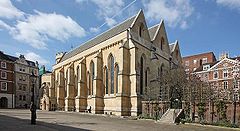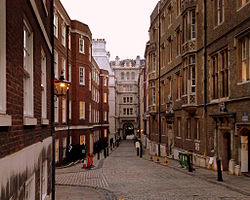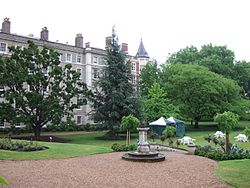Temple, London
| Temple | |
|---|---|
 | |
Location withinGreater London | |
| Sui generis | |
| Administrative area | Greater London |
| Region | |
| Country | England |
| Sovereign state | United Kingdom |
| Post town | LONDON |
| Postcode district | EC4 |
| Postcode district | WC2 |
| Dialling code | 020 |
| Police | City of London |
| Fire | London |
| Ambulance | London |
| UK Parliament | |
| London Assembly | |
TheTempleis an area of theCity of LondonsurroundingTemple Church.It is one of the main legal districts in London and a notable centre forEnglish law,since the middle ages to the present day. It consists of theInner Templeand theMiddle Temple,which are two of the fourInns of Courtand act as local authorities in place of theCity of London Corporationas to almost all structures and functions. Before the establishment of these Inns of Court, the Temple area was the precinct given to theKnights Templar(who built the church) until they were suppressed in 1312, but the area has retained the name from that time. It became a centre of the legal profession soon thereafter.
TheRoyal Courts of JusticeandTemple Barare just to the north andTemple tube stationborders to the southwest in theCity of Westminster.The associated area is roughly bounded by theRiver Thames(theVictoria Embankment) to the south, Surrey Street to the west,the StrandandFleet Streetto the north and Carmelite Street and Whitefriars Street to the east. The intervening Essex Street, two streets east of Surrey Street is the traditional western boundary, beyond which are affluent office/hotel and residential blocks, spread over large three street blocks which are closest to the station.
Extent
[edit]Temple, formally defined, contains manybarristers' chambersand solicitors' offices, as well as some notable legal institutions such as theEmployment Appeal Tribunal.[1]
Outside the jurisdiction but facing Temple tube station – in more dated use considered theSavoyand alternativelyStrandor Saint Clement Danes districts – are several buildings. These include the mid-rise Arundel House that hosts theInternational Institute for Strategic Studiesand a large multi-use site, in construction, otherwise facing the Strand, Arundel and Surrey Streets.[2]
Toponymy
[edit]
The name is recorded in the 12th century asNovum Templum,meaning 'New Temple'.[3]It is named after the then 'new' church (Temple Church) and surrounding holdings then belonging to theKnights Templar.(The 'Old Temple' was located inHolborn,roughly whereLincoln's Innnow stands.[4]) In addition to the church,Templenow appears in the names ofInner Temple,Middle Temple,theTemple Bar,and the nearbyTemple tube station.After the Knights were suppressed in 1312, their estate, the precinct of The Temple, was first divided intoInnerTemple andOuterTemple (denoting what was within theCity of Londonand what was without); while Inner Temple was later divided into Inner- and Middle-, Outer- generally fell into disuse.[3]
History
[edit]The Temple was originally the precinct of theKnights Templarwho erected theTemple Churchin honour ofSolomon's TempleinJerusalem.The Knights had two halls, whose modern successors are the Middle Temple Hall and the Inner Temple Hall. However, only the Inner Temple Hall preserves elements of the medieval hall on the site (specifically, the medieval buttery).
Upon the dissolution of the Knights Templar in 1312,Pope Clement Vgranted their possessions to theKnights Hospitaller.King Edward II(r. 1307–1327) ignored the claims of the Knights Hospitaller and divided the Temple into the Inner Temple and the Outer Temple, being the parts of the Temple within and without the boundaries of theCity of Londonrespectively. Not until 1324, after the prior,Thomas L'Archer,paid a substantial bribe,[citation needed]was the claim of the Knights Hospitaller to the Inner Temple officially recognised in England; but even then Edward II still bestowed it on his favourite,Hugh le Despencer,in spite of the Knights' rights. On Hugh's death in 1326 the Inner Temple passed first to the mayor of London and then in 1333 to one William de Langford, the King's clerk, for a ten-year lease.[5]
In 1337 the Knights petitionedEdward IIIto rectify the grant of consecrated land to a layman. As a result, the Inner Temple was divided between the consecrated land to the east and the unconsecrated land in the west, the eastern part continuing to be called Inner Temple and the western part becoming known as Middle Temple. Langford continued to hold Middle Temple at a reduced rent. In 1346, Langford's lease having by then expired, the Knights Hospitaller leased both Middle and Inner Temples to lawyers from St George's Inn andThavie's Innrespectively.[6]However lawyers had already occupied the Temple since 1320, when it belonged to theEarl of Lancaster.[7]
AfterHenry VIIIdissolved the Knights Hospitaller in the course of theEnglish Reformation,the barristers remained as tenants of the Crown, for an annual rent of £10 for each society (of Inner and Middle Temple). Their current tenure dates from a charter granted to them byJames Iin 1608. Originally a grant offee farm,the reversion was purchased fromCharles II,finally giving the lawyers absolute title.[8](In 2008 the 400th anniversary of the charter of James I was celebrated byElizabeth IIissuing newletters patentconfirming the original grant.[9])
The Outer Temple area was granted to the Bishop of Exeter, and eventually purchased by theEarl of Essex,Robert Devereux, who gave his name to Essex Street and Devereux Court, as well as Essex Court in Middle Temple.[10]
The area of the Temple was increased when the River Thames was embanked by the Victoria Embankment, releasing land to the south which previously lay within the tidal reaches of the river. The original bank of the river can clearly be seen in a drop in ground level, for example in the Inner Temple Gardens or the stairs at the bottom of Essex Street.
The area suffered much damage due to enemy air raids inWorld War II;many of the buildings, especially in the Inner Temple and Middle Temple inns, had to be rebuilt. Temple Church itself was badly damaged and had to be rebuilt. Nonetheless, the Temple is rich with Grade Ilisted buildings.
Inner Temple and Middle Temple
[edit]

The core of the district lies in the City of London and consists of twoInns of Court:Inner Temple(eastern part) andMiddle Temple(western part). The Temple Church is roughly central to these two inns and is governed by both of them.
The Inns each have their own gardens, dining halls, libraries and administrative offices, all located in their part of the Temple. Most of the land is, however, taken up by buildings in which barristers practise from sets of rooms known as chambers. There are some enclaves and exclaves in the boundary between the two Inns.
There was a long-running dispute between the two inns concerning which one was the older and which ought to have precedence over the other accordingly. This was resolved in 1620 when a tribunal of four judges declared that all four inns should be equal, "no one having right to precedence before the other."[11]
Until the 20th century, many of the chambers in the Temple were also residential accommodation for barristers; however, shortage of space for professional purposes gradually limited the number of residential sets to the very top floors, which are largely occupied by senior barristers and judges, many of whom use them aspied-à-terres,having their family home outside London. (There are also a limited number of rooms reserved for new barristers undertaking theBar Professional Training Course.) This, coupled with a generalmove of population out of the City of London,has made the Temple much quieter outside working hours than it appears, for example, in the novels ofCharles Dickens,which frequently allude to the Temple. Today, approximately a quarter of the chambers buildings in the Inner Temple and Middle Temple include residential accommodation, and current planning policy is to retain this where possible, to retain the special "collegiate" character of the Temple Inns of Court.[12]
There is also a 19th-century building called "TheOuter Temple",situated between Essex Court and Strand, just outside the Middle Temple boundary in the City of Westminster, but this is not part of the modern Inns of Court, has commercial landowners and is not directly related to the historic and long-defunct Outer Temple inn.
An area known asSerjeant's Innwas formerly outside the Temple, although at one time also occupied by lawyers (theSerjeants-at-Law). In 2001 it was acquired by the Inner Temple (it is adjacent and connected to King's Bench Walk in the Inner Temple) with a view to converting it into barristers' chambers. However it was instead converted into a hotel.
Liberty
[edit]Inner Temple and Middle Temple are two of the few remainingliberties,an old name for a geographical administrative division. They are independentextra-parochial areas,historically not governed by theCity of London Corporation[13]and are equally outside theecclesiastical jurisdictionof theBishop of London.They are today regarded as local authorities for most purposes,[14]but can delegate functions to theCommon Council of the City of London,as provided in theTemples Order 1971.[14]They geographically fall within the boundaries and liberties of the City of London, but can be thought of as independentenclaves.They are both part of the City ward ofFarringdon Without.TheParliamentary Boundaries Act 1832included The Temple withinCity of London parliamentary constituency.This change is among those which endedmalapportionmentand one voter voting in multiple parliamentary constituencies in England and Wales.[15]
The southern boundary of the Temple liberties was the natural bank of the Thames until theVictoria Embankmentwas constructed (1865–1870). The boundary is virtually unchanged – despite this notable engineering work, which meant that the Inner and Middle Temple lost their frontage to the Thames, albeit replaced widely with gardens. Both now own associated, law-related properties, just beyond the boundary. The Embankment – a major thoroughfare with anUndergroundline running beneath – is on paper never part of Temple – the cusp is where the gardens meet the road, where the spring tide (rarely flooded) part of the bank stood. The City of London's comparable limit is the centre of the Thames.
Temple Church
[edit]The Temple Church is aroyal peculiar.[16]It was built by the Knights Templar and consecrated in 1185. It is jointly owned by the Middle Temple and Inner Temple inns.
Temple tube station and pier
[edit]
Temple gives its name toTemple tube station,served by theDistrict(green) andCircle(yellow) lines, which is immediately southwest, between Temple Place and the Victoria Embankment. There is also a Temple Pier on the Victoria Embankment, near the Tube station immediately west of the Westminster-City of London boundary;HQSWellingtonis permanently moored there. TheWilfred bargewas moored here until its sinking duringStorm Henkin January 2024.[17]
See also
[edit]General:
Further reading
[edit]- Bellot, Hugh H.L. (1902).The Inner and Middle Temple: Legal, Literary and Historical Associations.London: Methuen & Co.
References
[edit]- ^"Contact Us".Employment Appeal Tribunal.
- ^"How to Find Us".International Institute for Strategic Studies.
- ^abAnthony David Mills (2001).Oxford Dictionary of London Place Names.Oxford University Press.ISBN0-19-280106-6.
- ^Bellot 1902, p. 7
- ^Bellot 1902,pp. 19–24.
- ^Bellot 1902,pp. 20–25.
- ^Bellot 1902,p. 20.
- ^Bellot 1902,p. 25.
- ^"Royalty and the Inn'"Middle Temple website, June 2017 (retrieved 12 November 2017).
- ^Bellot 1902,pp. 19–20.
- ^Bellot 1902,pp. 268–269.
- ^"Housing study area profile 10: Temples"(PDF).City of London Corporation,Department of the Built Environment. 31 March 2015. p. 6. Archived fromthe original(PDF)on 25 April 2016.
- ^City of London (Approved Premises for Marriage) Act 1996,1996, c. iv, Preamble
- ^ab"The Inn as a Local Authority".The Honourable Society of the Middle Temple.
- ^"2 & 3 Will. 4 c. 64 Schedule O 22".The Statutes of the United Kingdom of Great Britain and Ireland.Vol. 2 & 3 William IV. London: His Majesty's Statute and Law Printers. 1832. p. 351.Retrieved2 August2019.;Commissioners on Proposed Division of Counties and Boundaries of Boroughs (20 January 1832)."City of London".Parliamentary Representation: Further Return to an Address to His Majesty, Dated 12 December, 1831; for Copies of Instructions Given by the Secretary of State for the Home Department with Reference to Parliamentary Representation; Likewise Copies of Letters of Reports Received by the Secretary of State for the Home Department in Answer to Such Instructions. Reports from Commissioners on Proposed Division of Counties and Boundaries of Boroughs. Volume II Part I.Parliamentary Papers. Vol. 1831–32 HC 39 (141) 1. p. 117.Retrieved2 August2019.;alsoMetropolitan Boroughs Mapincluded with the report.
- ^Inner Temple Library website(retrieved 10 August 2018)
- ^"London flooding: Floating bar sinks during Storm Henk".BBC News.5 January 2024.Retrieved28 August2024.
External links
[edit]![]() Media related toTemple, Londonat Wikimedia Commons
Media related toTemple, Londonat Wikimedia Commons

